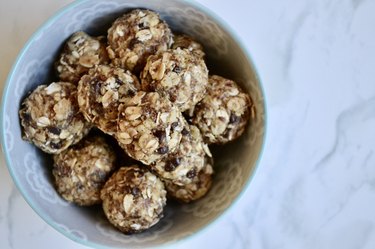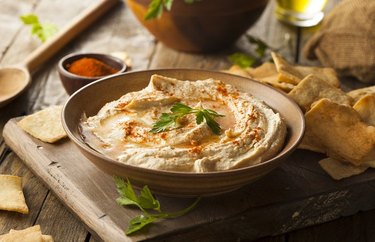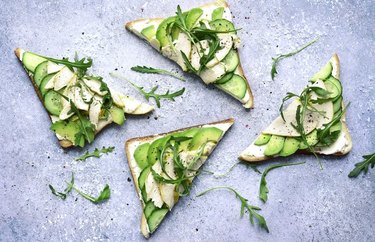There are so many different approaches to weight loss, but one steadfast tip you can always count on is focusing on fiber. Fortunately, the days of stirring fiber into your drinks for that extra roughage are long gone; the best way to get your fiber is from your food.
If you're going to include snacks in your weight-loss plan, then you'll want to make sure your snack contains a significant amount of the filling nutrient.
Video of the Day
Video of the Day
How Much Fiber Do You Need?
The recommendation for daily fiber from the National Academy of Medicine is between 25 and 38 grams, depending on your calorie intake (14 grams for every 1,000 calories). Most Americans fail to hit that target, averaging just 10 to 15 grams per day, per Harvard Health Publishing.
If you're low on the nutrient, don't panic yourself into eating it by the bucketload. Eating too much fiber before your body's used to it can backfire on your digestive system and lead to gastrointestinal distress.
So go slow and up your water intake, too. When you increase your fiber, you need more fluids to help move it through your system — water is the perfect way to do that.
Gradually start increasing your fiber intake, and soon you will be up to the recommendation and your body will be well adjusted to its new fiber levels. Increasing fiber by just 4 grams per day (the amount in a half-cup of raspberries) was linked to an additional 3 pounds of weight loss over six months in people on various diets in an October 2019 study in The Journal of Nutrition.
Fiber has been shown to reduce body weight independent of calorie restriction, per a February 2020 review in The American Journal of Clinical Nutrition. So this means if you simply increase your fiber while keeping your calories the same, you could see your weight start to go down.
If you're thinking fiber is pretty amazing, we agree.
Including a high-fiber snack in your food routine every day is a great way to start upping your fiber intake. If you're eating two snacks a day, aim for 5 grams of fiber per snack — this will have you well on your way to meeting, and possibly exceeding, the recommendation.
The Best High-Fiber Snacks for Weight Loss
1. Crunchy Chickpeas
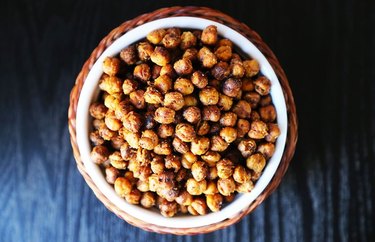
- Fiber: 5 grams in 1/4 cup
Beans are the perfect health food, since they're inexpensive, versatile and keep you full. But since it's highly unlikely you'll choose a can of beans for snack time, you'll want to get creative when incorporating them into your routine.
Chickpeas are naturally good sources of fiber, so take advantage of what nature has to offer. Roasted chickpeas are all the rage and for good reason — they are deliciously satisfying. If you're a crunchy snacker, these are going to hit the spot.
Crunchy chickpeas are widely available in stores, in all sorts of flavors, but they are just as easy to make at home.
Get the Crispy Roasted Chickpeas recipe and nutrition info here.
2. Oatmeal With Berries
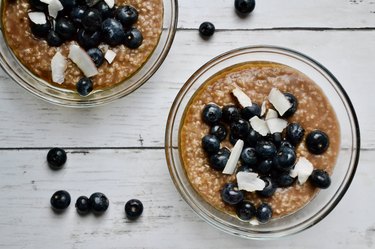
- Fiber: 7.2 grams in 1/4 cup steel-cut oats with 1/3 cup blueberries
Oatmeal and berries independently are both power players in the fiber game, and when paired together, they really outshine other snacks.
You may not associate oatmeal with snacking, but it can really fill you up. And if you use milk to make your oatmeal (instead of water), you get a good boost of protein as well.
Stick to flavoring your own oatmeal or buy unflavored quick oats to ensure there are no added sugars. We love flavoring with cinnamon for an extra kick.
Get the Cinnamon Steel Cut Oatmeal With Blueberries recipe and nutrition info from Sarah Pflugradt.
3. Broccoli With Hummus
- Fiber: 7.2 grams in 1/3 cup hummus and 1/2 cup raw broccoli florets
Hummus is a dip traditionally made from chickpeas (with a little tahini, olive oil, garlic and salt added in), so it's inherently fiber-filled. If you need a break from this spread, consider trying a dip made from other pureed beans: White beans, black beans and pinto beans all blend well and add a nice variety to snacking.
You may not think of hummus as a snack that can help you drop pounds, but in a December 2016 study in Nutrients specifically looking at the link between chickpeas, hummus and health, researchers indicated that diets high in pulses (beans and lentils) are typically associated with lower body weight and reduced risk for being overweight or obese.
Of course, you can buy hummus in your favorite grocery store, but it's so easy to make at home. You can change up the flavors with spices and then pre-portion out servings and keep them in the fridge until you're ready for your next snack.
Broccoli is an easy choice for a vegetable to dip, but carrots, sliced zucchini and cucumbers all work well too.
Get the Classic Hummus recipe and nutrition info here.
4. Avocado Toast
- Fiber: 6 grams
You don't have to be a millennial to enjoy this combo, but you do have to want fiber. Adding fiber-rich avocado to whole-grain toast — and a little everything bagel seasoning if you're feeling it — makes for a satisfying and nutritious snack. The fat in the avocado will help keep you full longer, which is key for weight loss.
The fat and fiber in avocado were shown to increase feelings of satiety over a high-carbohydrate meal in 31 people who were overweight, according to a May 2019 study in Nutrients.
In another study, avocado consumers were shown to have higher diet quality overall, and eating avocados may reduce overall food consumption and reduce feelings of hunger, per March 2019 research in Nutrients. Researchers pin those good attributes to the fiber, monounsaturated fatty acids and phytonutrients in avocado.
For your toast, choose whole-grain bread and stick with no more than one half of a small avocado for the biggest snacking benefit. Add some lean protein, like turkey, and some spice on top for variety. If you don't have a seasoning blend, try a little sriracha or hot sauce or stick with the always-reliable lemon juice, salt and pepper.
Get the Free Bird Avocado Toast and Turkey recipe and nutrition info here.
5. Energy Bites
- Fiber: 4.5 grams in 3 bites
These bites are filled with oats, nut butter and ground flaxseed, making them a powerful, fiber-filled snack. They are a cinch to make, too, and store well in the fridge for easy munching.
Store-bought energy bites are often brimming with sugar, which is why you may want to mix up your own. Consider making a big batch and portioning them out for your snacks all week long.
Nuts and nut butter are both a source of fiber and heart-healthy fats, which also helps to keep you full and satisfied. Flaxseeds also contain fiber — 2 grams per tablespoon — which can help you reach your intake goals.
And just a tip: The body absorbs ground flaxseeds better than whole ones, which can pass right through your digestive tract, according to the Mayo Clinic.
Get the Peanut Butter and Oats Energy Bites recipe and nutrition info from Sarah Pflugradt.
- Harvard Health Publishing: "Should I Be Eating More Fiber?"
- Nutrients: "The Nutritional Value and Health Benefits of Chickpeas and Hummus"
- Nutrients: "Using the Avocado to Test the Satiety Effects of a Fat-Fiber Combination in Place of Carbohydrate Energy in a Breakfast Meal in Overweight and Obese Men and Women: A Randomized Clinical Trial"
- Nutrients: "Avocado Intake, and Longitudinal Weight and Body Mass Index Changes in an Adult Cohort"
- Mayo Clinic: "Does Ground Flaxseed Have More Health Benefits Than Whole Flaxseed?"
- The American Journal of Clinical Nutrition: "Can Dietary Viscous Fiber Affect Body Weight Independently of an Energy-Restrictive Diet? A Systematic Review and Meta-Analysis of Randomized Controlled Trials"
- National Academy of Medicine: "Dietary Reference Intakes"
- The Journal of Nutrition: "Fiber Intake Predicts Weight Loss and Dietary Adherence in Adults Consuming Calorie-Restricted Diets: The POUNDS Lost (Preventing Overweight Using Novel Dietary Strategies) Study"
